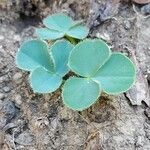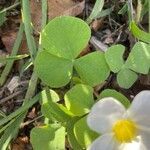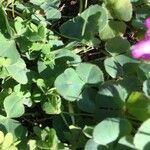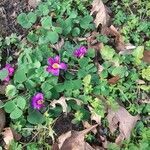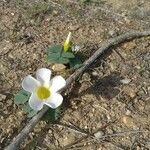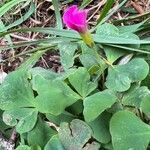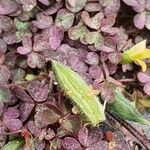Apparently acaulous perennial, but with underground stem above bulb; bulb narrow-ovoid; outer scales dark brown or blackish, ± shining, viscid, with inconspicuous nerves. Lvs radical, 3-foliolate. Petiole (1)-2-10-(20) cm long, hairy; stipules 3-7 mm long, appearing as a broad wing, sometimes ciliate. Lamina of leaflets sessile, somewhat unequal, the terminal larger and 10-35-(45) × 1-37-(45) mm, broadly obovate, sometimes broader than long, glabrous above, hairy beneath and densely marked with short, black, glandular dashes when dry; margins long-ciliate; base cuneate; apex rounded; lateral leaflets somewhat asymmetric at base. Fls solitary, erect; peduncles 1-11 cm long, hairy. Bracts 2-3 mm long, linear-subulate, usually in lower 1/2 of pedicel; calli 0. Sepals 6-7.5 mm long, elliptic, with longitudinal black streaks when dried, with dense long, white cilia, otherwise glabrous; calli 0. Corolla forming a deep cup 2.5-4 × 2.5-3 cm, with a lower, tubular part; petals 2-4 cm long, ± suborbicular, glabrous except for ciliate margins; lower part yellowish; limb usually rose or purplish, sometimes white flushed pink outside. Stamens at 2 levels, glabrous; filaments with broad membranous wing, often almost to apex in shorter stamens. Styles < or > longer stamen whorl, hairy. Capsule not seen.
Perennial herb with stems hardly exserted; bulb ovoid, pointed, 1–3 cm long, tunics blackish brown, rigid, viscid, with inconspicuous veins; bulbils formed on rhizome. Indumentum of simple, eglandular hairs. Stipules membranous, to c. 4 mm long, abruptly tapering into petiole. Leaves crowded at apex of rhizome, palmately trifoliolate; petiole 1–17 cm long, usually densely villous; leaflets sessile, somewhat unequal, the terminal often larger, broad-obovate to rhombic, 5–45 mm long, 5–50 mm wide, rounded or sometimes emarginate, green and glabrous above, often purplish below with many translucent dots and streaks that dry black, pubescent or with hairs confined to veins, margins ciliate. Inflorescences basal, 1-flowered; peduncles 1–38 cm long, shorter than or scarcely exceeding leaves, usually pilose. Bracts situated usually in lower half of pedicel, linear-subulate, 2–3 mm long, calli absent. Sepals lanceolate, 5–8 mm long, striate with translucent lines, ciliate, calli absent. Petals broadly cuneate-obovate, 10–40 mm long, pink to deep magenta or sometimes white, with yellow base, glabrous except for ciliate margins. Stamens at 2 levels; filaments with broad membranous wing, glabrous. Ovary pubescent on the upper half. Styles hairy. Capsules not developed in Australia.
Herbs perennial, acaulous, rhizomes present, <slender, sparsely scaly>, stolons absent, bulb solitary, <1–2.5 cm>, or with clustered bulblets; bulb scales <black, thickened>, not prominently nerved. Leaves basal, <rarely absent at flowering>; petiole (1.5–)3–5 cm; leaflets 3, green to deep purple abaxially, green adaxially, broadly obovate to obtriangular or broadly rounded-rhombic, 10–20 mm, not lobed, <apex truncate to rounded or obtuse, rarely slightly emarginate, margins and> abaxial surface hairy, adaxial surface glabrous, oxalate deposits absent. Inflorescences 1-flowered; scapes 1.5–6(–8) cm, sparsely to moderately villous, <hairs eglandular>. Flowers tristylous; sepal apices without tubercles; petals yellow basally, usually purple to red, pink, salmon, or white, rarely yellow, distally, 25–35 mm. Capsules not seen.
Acaulescent geophyte, up to 150 mm tall. Bulb tunics gummy, blackish brown. Leaves spreading or prostrate, petioles sometimes ± compressed, leaflets 3, ± cuneate-rotund or rarely rhomboid-oblong, hairy and purple beneath, pellucid-streaked when fresh, black-streaked when dry, ciliate. Flowers 1 per peduncle with alternate bracts in lower half, purple, pink, yellow or white, with a yellow tube.
Herb, up to 150 mm tall. Leaflets and sepals with faint pellucid streaks which turn dark in drying. Corolla tube narrowly cyathiform. Bracts low down on peduncle. Flowers rose-purple, deep rose, pale violet, salmon, yellow, cream or white, tube yellow.
Acaulescent geophyte, up to 0.15 m high. Bulbs large, often gummy. Leaves trifoliolate, leaflets broadly cuneate to rotund, covered with semi-transparent streaks and spots. Flowers pink or white with yellow tube. Flowering time May-Sept.
Acaulescent geophyte, bulb large, gummy. Leaves trifoliolate, leaflets transversely obovate, ciliate, hairy and purple beneath, black-streaked when dry. Flowers purple, yellow or white with yellow tube.
A herb. It forms a bulb. It grows 10-15 cm high and spreads 10-15 cm wide. There are 3 rounded leaflets. The flowers are red, pink or white.
